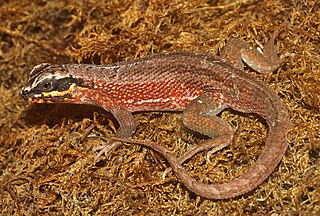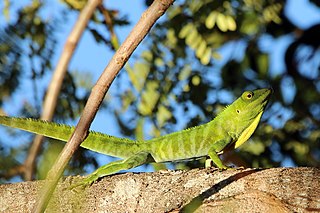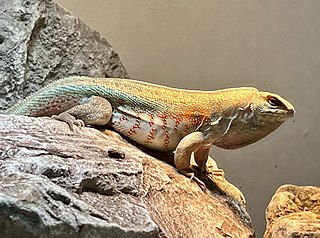
Leiocephalidae, also known as the curlytail lizards or curly-tailed lizards, is a family of iguanian lizards restricted to the West Indies. One of the defining features of these lizards is that their tail often curls over. They were previously regarded as members of the subfamily Leiocephalinae within the family Tropiduridae. There are presently 30 known species, all in the genus Leiocephalus.
Cochran's croaking gecko, also commonly known as Cochran's Caribbean gecko and the Navassa gecko, is a species of lizard in the family Sphaerodactylidae. The species was described in 1931 by Chapman Grant and named after notable American herpetologist and artist Doris Mable Cochran. The species received one of its common names from the loud croaking call of the male during the mating period.

Cyclura rileyi, commonly known as the Bahamian rock iguana or the San Salvador rock iguana, is a critically endangered species of lizard in the family Iguanidae. The species is native to three island groups in the Bahamas, and is in decline due to habitat encroachment by human development and predation by feral dogs and cats. There are three subspecies: the Acklins ground iguana, the White Cay iguana, and the nominotypical subspecies.
The Navassa curly-tailed lizard or Navassa curlytail lizard is an extinct lizard species from the family of curly-tailed lizard (Leiocephalidae). It is known only from the holotype, a female specimen from which it was described in 1868. A possible second specimen which was collected by Rollo Beck in 1917 was instead identified as a Tiburon curly-tailed lizard by herpetologist Richard Thomas in 1966.

The Martinique curlytail lizard is an extinct species of lizard in the family of curly-tailed lizard (Leiocephalidae).

The Hispaniolan masked curly-tailed lizard is a lizard species from the family of curly-tailed lizard (Leiocephalidae). It is also known as the Hispaniolan masked curlytail, Haitian curlytail lizard and the green-legged curly-tail. endemic to the Caribbean island of Hispaniola.

Leiocephalus carinatus, commonly known as the northern curly-tailed lizard or saw-scaled curlytail, is a species of lizard in the family Leiocephalidae.
Leiocephalus loxogrammus, commonly known as the Rum Cay curlytail lizard and the San Salvador curlytail, is a lizard species in the family of curly-tailed lizard (Leiocephalidae). The species is endemic to The Bahamas and is only known to be found on San Salvador Island and Rum Cay.
Leiocephalus greenwayi, commonly known as the East Plana curlytail and the Plana Cay curlytail lizard, is a species of lizard in the family of curly-tailed lizards (Leiocephalidae). The species is native to the West Indies.

Anolis garmani, also known commonly as the Jamaican giant anole, the Jamaican anole, and the Jamaica giant anole, is a species of lizard in the family Dactyloidae. The species is endemic to Jamaica, but has been introduced to Florida.

The Hispaniolan curlytail lizard, also known as the Hispaniolan khaki curlytail, the red-sided curlytail lizard, the red-sided curly-tailed lizard, or Schreibers's curly-tailed lizard, is a common lizard species in the family Leiocephalidae. It is native to Hispaniola in the Caribbean, and an introduced population is found in southern Florida. There are two recognized subspecies.
Pholidoscelis maynardi, commonly known as the Great Inagua ameiva, Inagua ameiva, or Inagua blue-tailed lizard, is species of lizard, a member of the family Teiidae. The species is endemic to the Bahamas. Three subspecies have been described.

The common Puerto Rican ameiva or Puerto Rican ground lizard is a species of lizard in the whiptail family.

Pholidoscelis wetmorei is a species of lizard in the family Teiidae (whiptails). The species is endemic to Puerto Rico. Its common names include the Puerto Rican blue-tailed ameiva, Wetmore's ameiva, and blue-tailed ground lizard.
The striped Caribbean gecko, also known commonly as the Inagua croaking gecko and the Inagua gecko, is a species of lizard in the family Sphaerodactylidae. The species is endemic to the Bahamas.
Shreve's least gecko, also known commonly as the northwest Haiti blotched sphaero and the northwest Haitian blotched geckolet, is an endangered species of lizard in the family Sphaerodactylidae. The species is endemic to Haiti.
Anolis ahli, also known commonly as Ahl's anole and the Escambray blue-eyed anole, is a species of lizard in the family Dactyloidae. The species is endemic to Cuba.

Anolis cooki, also known commonly as Cook's anole, Cook's pallid anole, and the Guanica pallid anole, is a species of lizard in the family Dactyloidae. The species is endemic to Puerto Rico.
Anolis juangundlachi, also known commonly as the Finca Ceres anole and the yellow-lipped grass anole, is a species of lizard in the family Dactyloidae. The species is endemic to Cuba.
Caribicus darlingtoni, also known commonly as Darlington's galliwasp and the Hispaniolan striped galliwasp, is a species of lizard in the family Diploglossidae. The species is endemic to the Dominican Republic on the Caribbean island of Hispaniola.










